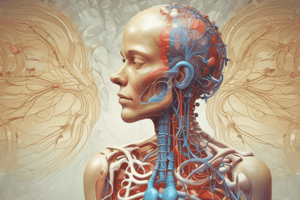Podcast
Questions and Answers
What is the key factor for aerobic metabolism?
What is the key factor for aerobic metabolism?
- Hydrogen ions
- Hemoglobin
- Carbon dioxide
- Oxygen (correct)
Where is oxygen carried in the blood?
Where is oxygen carried in the blood?
- Both bound to hemoglobin and dissolved in plasma (correct)
- In white blood cells
- Only bound to hemoglobin
- Only in plasma
What is the effect of oxygen combining with hemoglobin in the lungs on the transport of carbon dioxide?
What is the effect of oxygen combining with hemoglobin in the lungs on the transport of carbon dioxide?
- It has no effect on the transport of carbon dioxide
- It increases the amount of carbon dioxide in the plasma
- It increases the affinity of hemoglobin for carbon dioxide
- It decreases the affinity of hemoglobin for carbon dioxide (correct)
What is the effect of the increased acidity of hemoglobin on the transport of carbon dioxide?
What is the effect of the increased acidity of hemoglobin on the transport of carbon dioxide?
What is the relationship between the amount of gas dissolved in a solution and its partial pressure according to Henry's Law?
What is the relationship between the amount of gas dissolved in a solution and its partial pressure according to Henry's Law?
What is the name of the effect that describes the decrease in affinity of hemoglobin for oxygen in the presence of carbon dioxide?
What is the name of the effect that describes the decrease in affinity of hemoglobin for oxygen in the presence of carbon dioxide?
What is the ratio of the volume of red blood cells to the total volume of blood?
What is the ratio of the volume of red blood cells to the total volume of blood?
What is the difference between the chlorides content of arterial and venous red blood cells?
What is the difference between the chlorides content of arterial and venous red blood cells?
What is the name of the scientist who postulated the effect of oxygen on the transport of carbon dioxide?
What is the name of the scientist who postulated the effect of oxygen on the transport of carbon dioxide?
What percentage of oxygen is carried in the blood by binding to hemoglobin?
What percentage of oxygen is carried in the blood by binding to hemoglobin?
What happens to the affinity of hemoglobin for oxygen in the presence of carbon dioxide?
What happens to the affinity of hemoglobin for oxygen in the presence of carbon dioxide?
What is the result of the increased acidity of hemoglobin on the transport of carbon dioxide?
What is the result of the increased acidity of hemoglobin on the transport of carbon dioxide?
Where does the Bohr's effect occur?
Where does the Bohr's effect occur?
What is the effect of oxygen combining with hemoglobin in the lungs on the transport of carbon dioxide?
What is the effect of oxygen combining with hemoglobin in the lungs on the transport of carbon dioxide?
Flashcards are hidden until you start studying
Study Notes
Oxygen Transport
- Essential for aerobic metabolism and used by cells in maximum quantity.
- Continuous supply of oxygen is required as there is no storage system in tissues.
- Carried in blood in two forms:
- Bound to hemoglobin (Hb) in red blood cells: 97-98% of total oxygen transport.
- Dissolved in plasma, limited by Henry's Law which states that the amount of gas dissolved in a solution is proportional to its partial pressure.
- Hematocrit measures the volume ratio of red blood cells to the total volume of blood.
- Venous red blood cells (RBCs) are more fragile compared to arterial RBCs; chloride content is higher in venous blood.
Carbon Dioxide Transport
- Haldane Effect describes how oxygenation of hemoglobin in the lungs affects carbon dioxide transport.
- When oxygen binds to hemoglobin, it increases the acid strength of hemoglobin:
- More acidic hemoglobin reduces its affinity for carbon dioxide, encouraging the release of CO2 bound in the carbamino form.
- Increased acidity results in the release of hydrogen ions, raising blood pH and further decreasing CO2 binding to hemoglobin.
Differences Between Bohr’s and Haldane’s Effects
-
Bohr’s Effect:
- Presence of carbon dioxide decreases hemoglobin's affinity for oxygen.
- Described by John Scott Haldane in 1860.
- Occurs primarily in tissues where CO2 concentration is high.
-
Haldane Effect:
- Binding of oxygen to hemoglobin displaces carbon dioxide.
- Postulated by Danish physiologist Christian Bohr in 1904.
- Occurs mainly in the lungs where oxygen concentration is high.
Studying That Suits You
Use AI to generate personalized quizzes and flashcards to suit your learning preferences.




